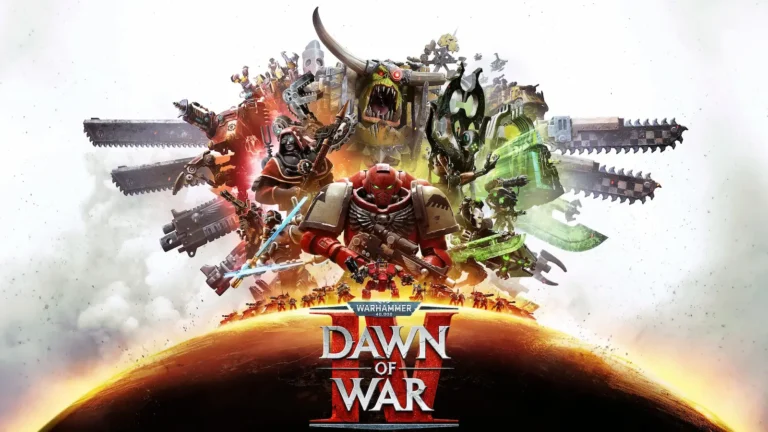Dawn of War IV Overview
- Release Window: 2026
- Platforms: PC (Steam confirmed and available to Wishlist)
- Setting: Kronus, centuries after Dawn of War: Dark Crusade
- Campaigns: 4 full faction storylines, written by Black Library author John French
- Total Missions: Over 70, with branching paths and cinematic cutscenes
- Launch Factions:
- Space Marines (Blood Ravens focus, Cyrus returns)
- Orks (classic WAAAGH gameplay with new units like Squighog cavalry)
- Necrons (slow, resilient, reanimation mechanics)
- Adeptus Mechanicus (first time fully playable, focus on networks and firepower)
- Imperial Guard: Present in tutorial and campaign with Guardsmen, Sentinels, Rogal Dorn tanks, and Bombast Guns. Likely DLC faction.
- Core Features:
- Proper base building with unique faction mechanics
- Requisition and power resource system, 300 population cap
- Sync kills with over 10,000 animations
- Reinforce and retreat systems
- Unit veterancy and upgrades
- Co-op campaign and returning Last Stand mode
- Army Painter Confirmed
Warhammer 40K Dawn of War 4 Story Returns to Kronus
Dawn of War IV isn’t just shaping up to be another RTS with skirmish and multiplayer. It’s going all-in on single-player. Each of the four launch factions will get its own full-length campaign, written by Black Library veteran John French, with branching paths, planetary choices, and more than 70 missions. That makes it the biggest single-player package in the history of the series.
Developers have said the structure takes a lot from Dark Crusade. You’ll have a world map to choose missions from, with non-linear paths, side objectives, and the chance to tackle things in your own order.
At the same time, there’s also some Dawn of War II-style dialogue and choice-making layered in. So it isn’t just repeating the past, it’s mixing familiar elements with new twists.
The stage for all this is Kronus, the iconic battleground of Dark Crusade. Only now, decades have passed, and the Blood Ravens are coming back to a world scarred by their earlier victory.
Games Workshop actually suggested Kronus as the setting, partly because it sits on the wrong side of the Great Rift. Lore-wise, it makes sense too. The Chapter is scattered and broken, and they’re returning here in the hope of finding recruits and survivors. Naturally, this being Warhammer 40k, things spiral into disaster almost immediately.
For canon, the team has locked in the Space Marine win in Dark Crusade as the baseline. The stories of Dawn of War II and III happened, but they aren’t central to what’s unfolding now. This game is focused on the here and now of Kronus, seen from four lenses: Space Marines, Orks, Necrons, and the Adeptus Mechanicus.
There’s also one glaring omission fans will notice: Gabriel Angelos. The Blood Ravens’ Chapter Master, the hammer-swinging face of the trilogy, is gone. According to creative director Jan Theysen, Angelos had simply become too powerful by DoW3. Putting him in would either break the balance or require a tired trope like “he lost his powers.”
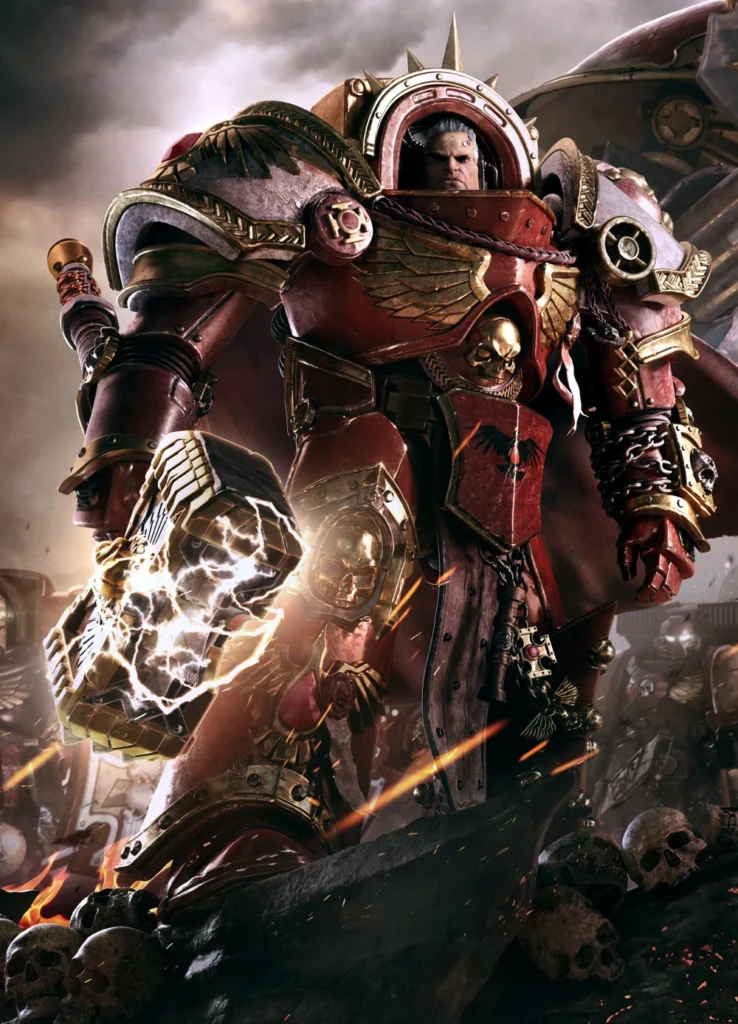
Instead, the spotlight shifts back to Cyrus, the gravel-voiced scout from DoW2 who now fights in Primaris Phobos armor, and Jonah Orion, the Chapter Librarian introduced in Chaos Rising.
Both have been redesigned to reflect the Primaris upgrade. Both are intentionally more grounded commanders, meant to feel like leaders working with an army, not superheroes carrying it.
The Orks also get a familiar face: Warboss Gorgutz. He’s managed to survive every Dawn of War outing so far, always scheming, always finding new enemies to krump. His return is both a nod to series veterans and a promise that the Orks’ campaign will be as rowdy and unpredictable as ever.
The story won’t just be told through text and brief in-game chatter either. Each faction gets its own CGI intro, four in total, plus over 40 minutes of animated cutscenes woven through the campaigns.
The Gamescom trailer itself was a montage of these moments, giving a taste of the scale and tone King Art is going for.
Put together, it feels like the best mix of what’s worked before. The freedom and replayability of Dark Crusade. The character-driven storytelling of DoW2. And the cinematic punch of a modern Warhammer release.
Kronus is back on the table, and this time it’s set to be bigger, bloodier, and far more complex.
Dawn of War IV Gameplay
Base Building is Back, Baby!
One of the most common demands from the community after Dawn of War III was simple: bring back proper base building. Dawn of War IV answers that call.
The game uses a traditional RTS model with an HQ and a variety of specialized structures. Each faction builds differently. Space Marines do not rely on workers. Instead, their buildings are deployed from orbit. You can place them anywhere on the map.
The tradeoff is that construction speed slows dramatically the further from your HQ you go. This creates an interesting risk–reward mechanic. You could try to sneak a barracks close to the enemy’s base, but it will take so long to build that your opponent might spot and destroy it before it finishes.
Orks go in the opposite direction. Their buildings are cheap, fast to place, and can be spammed all over the battlefield. Their economy and production are chaotic but flexible. It perfectly captures the Ork aesthetic of ramshackle war camps sprouting up wherever they fight.
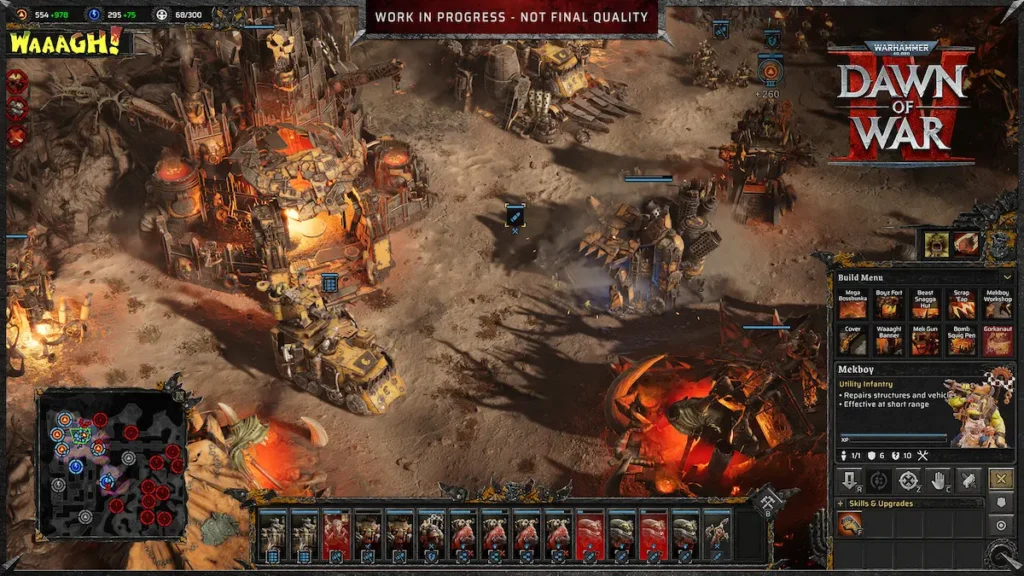
The Adeptus Mechanicus have a unique network system. The developers expanded on this in interview, describing it as a ‘Nospheric Network’ that not only strengthens nearby units but also provides scanning effects in the fog of war, giving the AdMech unmatched battlefield awareness.
The AdMech base becomes almost like an interconnected machine, reflecting their lore as masters of technology.
Necrons again stand apart. They do not gather requisition and power in the same way as other factions. Instead, they expand by constructing new tomb structures that fuel their army. Their production feels more like a slow awakening of an ancient dynasty, with obelisks and monoliths serving as focal points of power.
Resources and Economy – Some Familiar Mechanics
Requisition and power are the classic resources. Nodes across the map generate these, and players must capture and upgrade them. Listening posts and generators return to secure points.

The population cap in the demo was 300. This is far higher than in previous titles. In practice, Space Marines rarely hit that cap due to their elite unit sizes. Orks, however, can easily swell toward it with endless Boyz. The asymmetry between factions is already clear: one side fields a handful of super-soldiers, the other floods the map with crude mobs.
This mirrors the tabletop game and provides a strong identity for each army. Players will need to adapt their strategies depending on whether they prefer quality or quantity.
Cover and Garrisons Made Simple(r)?
Cover returns but in a simplified form compared to Dawn of War II. Units can move into sandbags, ruins, or natural terrain to gain protection. Importantly, the pathfinding works smoothly. Squads align properly behind cover rather than scattering awkwardly.
Neutral bunkers can be captured and garrisoned. Once occupied, they resist small arms fire but are vulnerable to grenades or flamers. This encourages combined arms tactics. Charging bunkers blindly with basic infantry will fail. Using explosives to flush them out will succeed.
This is a middle ground between Dawn of War I’s basic cover icons and Dawn of War II’s highly detailed, sometimes fiddly cover system.
Sync Kills and Combat Animations Look Amazing
One of the most beloved features of Dawn of War has always been sync kills. Seeing a Space Marine drive his chainsword through an Ork or a Dreadnought smash an enemy vehicle never got old. Dawn of War IV takes that idea and expands it massively.
Combat animations are now fully synchronized. Every unit has unique fight interactions with every other unit type. That means when two squads clash, the models pair off and fight convincingly. No more soldiers swinging at thin air.
The developers have created over 10,000 animations for this system. Early examples shown include a Redemptor Dreadnought grappling a Necron Tomb Spyder and an Ork Deff Dread body-slamming a Space Marine Dreadnought. These are not rare finishing moves. They happen constantly in melee, making battles feel alive and cinematic.
Even ranged units benefit. Necron Warriors fire in eerie synchronized volleys, creating a chilling sense of inevitability. The spectacle matters, because Warhammer 40,000 is as much about atmosphere as it is about mechanics.
Reinforcements and Retreat
Squads can be reinforced on the battlefield, similar to Dawn of War I. This allows attrition-based combat where you can top up units after fights. Reinforcement will probably costs slightly more than building at base, to prevents abuse.
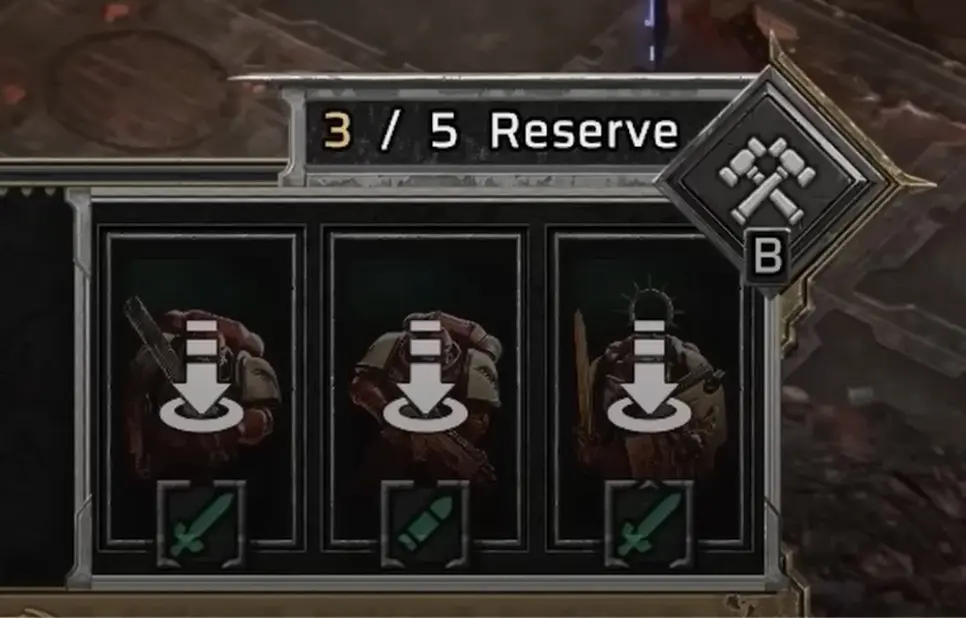
There is also a retreat function, but it does not give squads an unrealistic speed boost. Units simply turn and run to the nearest safe building. This creates tactical decisions. Do you risk reinforcing a squad in combat, bleeding resources, or do you retreat them to preserve veterans for later?
Veterancy is important. Units gain levels as they fight, unlocking new abilities and improving stats. Losing a veteran squad hurts. This system rewards careful preservation of troops.
Upgrades and Wargear
Units can be customized with upgrades. Intercessors can swap their rifles for stalker bolters or auto-bolters, shifting their role between anti-infantry and anti-armor. Assault Intercessors can add thunder hammers for elite combat or flamers for clearing hordes.
Vehicles like the Redemptor Dreadnought can mount plasma incinerators or gatling cannons. Terminators can be configured for melee or ranged roles. Every choice costs requisition and power, so players must weigh the benefits carefully.
Faction-wide upgrades also exist. These do not cost resources, only time. They take several minutes to complete. For example, Space Marines can research faster capture speeds or better armor for their squads. These decisions shape overall strategy.
Heroes and Army Abilities
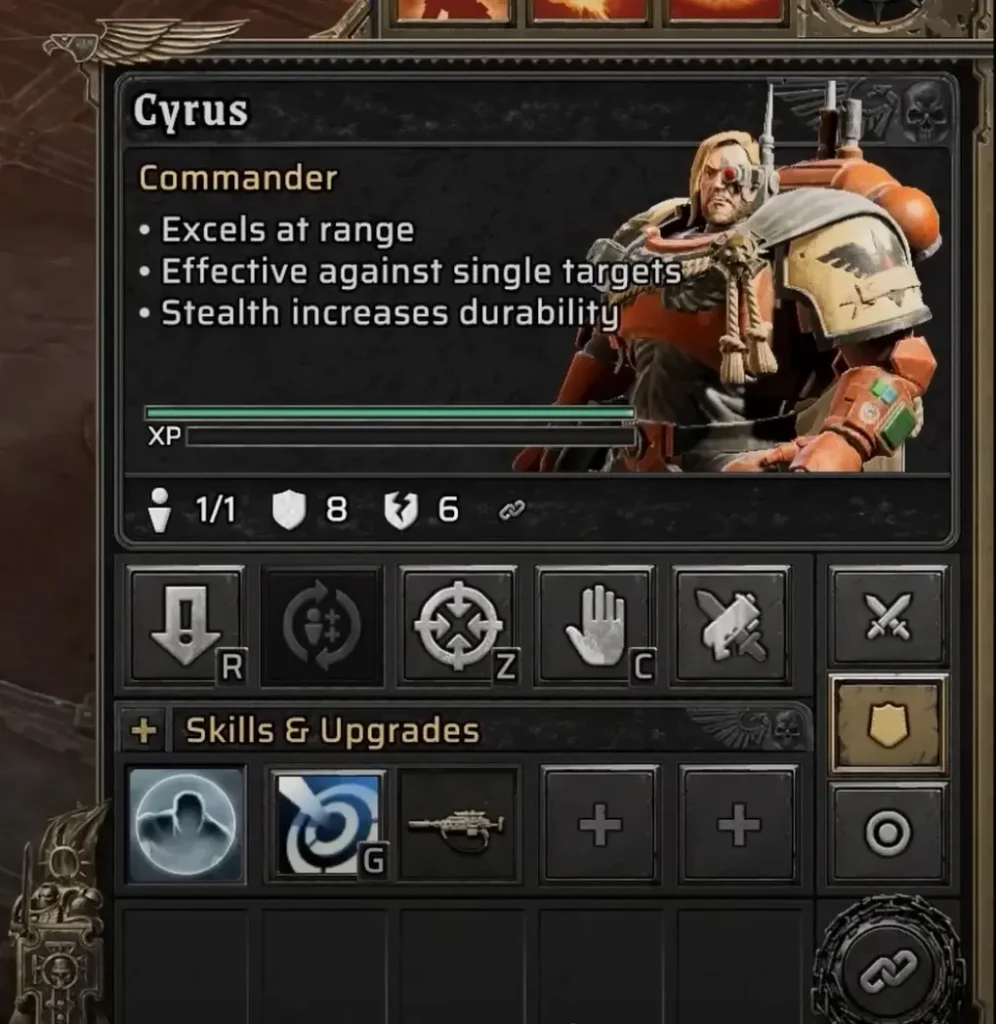
Heroes play a role but are not overpowered like in some RTS games. Cyrus is one example. He begins with a sniper rifle that provides a powerful single-shot ability. He can swap to a plasma gun for a more versatile role. As he levels up, he unlocks new abilities and passive bonuses.
Heroes can also be attached to squads, just like in Dawn of War II. This allows them to act as leaders and provide buffs.
Each faction has global army abilities fueled by a bar that fills during combat. For Space Marines these include:
- Veteran Boost: instantly levels up a squad, increasing health and unlocking abilities
- Air Strike: a strafing run from a Thunderhawk that devastates an area but can harm allies
- Orbital Bombardment: a massive area-of-effect attack that obliterates armies and buildings
Other factions have their own equivalents. Orks build Waaagh energy as they fight, leading to destructive powers. Adeptus Mechanicus may use their network to call down advanced strikes. Necrons may channel energy through tomb structures for devastating effects.
Maps and Strategy
The demo map shown was asymmetrical, with choke points and flanking routes. It was shaped like a circle with intersecting paths. This design encourages tactical positioning rather than simple mirror matches.
Players can fortify choke points with turrets and bunkers. Orks can flood through multiple angles. Space Marines can deep strike reserves into key spots using drop pods.
The map design reflects lessons from modern RTS titles. It provides strategic variety without forcing pure symmetry.
Modes and Multiplayer
Multiplayer includes skirmish against AI, custom lobbies, and competitive 1v1, 2v2, and 3v3 matches. The devs confirmed tthat the maps are larger than anything in previous Dawn of War games. Dozens of multiplayer maps will ship at launch, alongside co-op campaigns.
The popular Last Stand mode from Dawn of War II is returning. Three players each control a hero and fight waves of enemies in an arena. Heroes can be customized with wargear between matches. This mode was missing in DoW III and fans are thrilled to see it back.
Campaigns can be played in co-op with two players. This allows friends to tackle missions together, controlling different portions of the army. It was a highlight of Dawn of War II’s campaign and it fits perfectly here.
Dawn of War IV Factions Overview
Space Marines
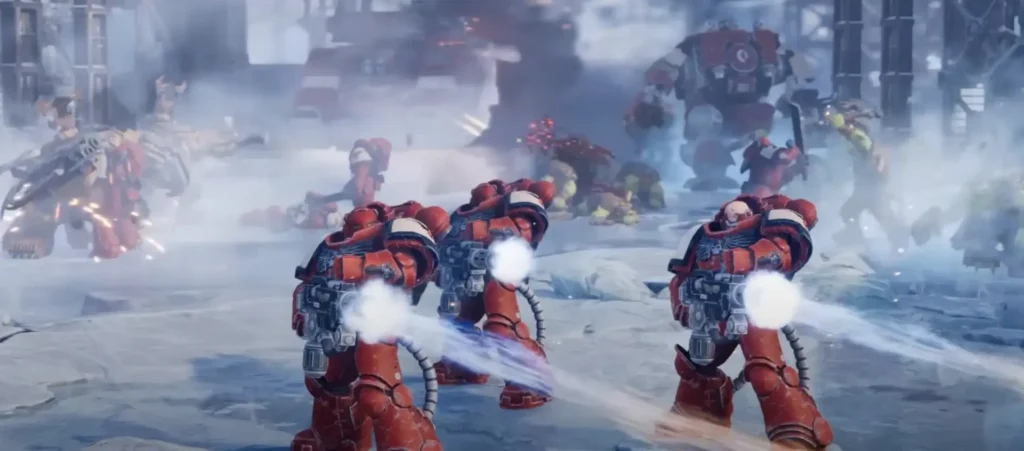
The Adeptus Astartes are the iconic face of Warhammer 40,000 and once again the poster boys of Dawn of War. In Dawn of War IV, the campaign highlights the Blood Ravens, a chapter renowned for both their nobility and their barely-contained passion for “collecting” relics.
Long-time fans will be pleased to see the return of Cyrus, the grizzled scout from Dawn of War II, now leading from the front as a hero character.
Space Marines are designed around elite squads, tactical flexibility, and surgical strikes. While you will never field as many units as the Orks or Guard, each squad has incredible staying power, a suite of upgrade options, and the ability to reinforce in the field.
Their unique mechanic, Drop Pod deployment, allows them to insert reinforcements directly into combat. Combined with global abilities like orbital bombardments, Space Marines embody the fantasy of a small but unstoppable strike force, striking wherever the enemy is weakest.
Playstyle: Elite, flexible, mobile.
- Strong individual squads.
- Use of drop pods for rapid deployment.
- Versatile upgrades to adapt to threats.
Army abilities: Veteran Boost, Air Strike, Orbital Bombardment.
Space Marine Units in Dawn of War IV
| Unit | Role | Playstyle and Strengths | Status |
|---|---|---|---|
| Intercessors | Core infantry | Versatile backbone of the army. Adaptable bolter loadouts make them effective against infantry or armor. | Confirmed |
| Assault Intercessors | Jump pack melee | Shock troops. Great for flanking and breaking entrenched ranged units. Can take thunder hammers or flamers. | Confirmed |
| Bladeguard Veterans | Elite melee | Durable frontline anchors. Hold the line while ranged squads clean up. | Confirmed |
| Terminators | Heavy infantry | Slow but nearly indestructible. Configurable for melee or ranged. Ideal for late-game pushes. | Confirmed |
| Eradicators | Anti-vehicle specialists | Small, elite squads with melta or plasma weapons. Devastating against armor, fragile if unsupported. | Confirmed |
| Infiltrators & Eliminators | Scouts and snipers | Stealth and recon tools. Harass enemies, spot ambushes, and assassinate priority targets. | Confirmed |
| Redemptor Dreadnought | Heavy walker | Flexible war machine with customizable loadouts. Dominant frontline presence. | Confirmed |
| Invictor Warsuit | Light walker | More mobile than a Dreadnought. Useful for aggressive openings and infiltration. | Confirmed |
| Gladiator Reaper | Tank (anti-infantry) | Anti-horde specialist. Perfect for cutting through Orks or Guard. | Confirmed |
| Repulsor Executioner | Tank (anti-armor) | High-tech heavy tank. Excellent at destroying enemy armor and fortifications. | Confirmed |
Special mechanics include reinforcing anywhere, deep strike deployment, and squad veterancy that provides meaningful upgrades.
Orks
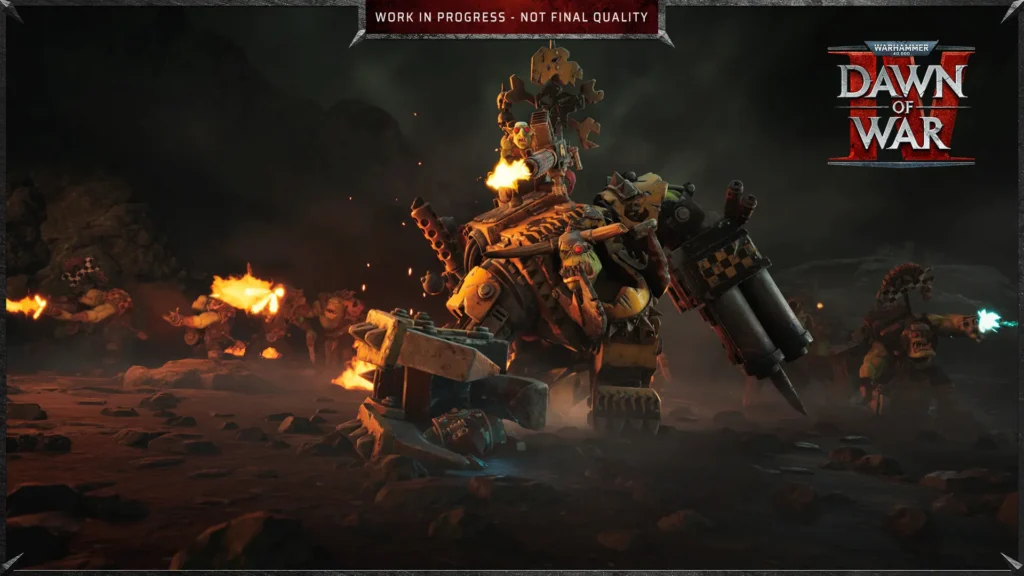
If you want noise, chaos, and green-skinned mayhem, the Orks deliver. They are the eternal antagonists of the galaxy, thriving on war itself. For them, Kronus is not just another battlefield but another chance for the biggest and loudest WAAAGH!
In gameplay terms, Orks are all about cheap, spammable units, sprawling bases, and raw aggression. Their buildings cost very little and can be scattered across the map, letting them flood the field with Boyz and ramshackle walkers.
The Ork roster includes cavalry like Squighog Boyz and classic heavy machines such as Deff Dreads and Gorkanauts. Their global powers are likely fueled by Waaagh energy, rewarding constant fighting and momentum.
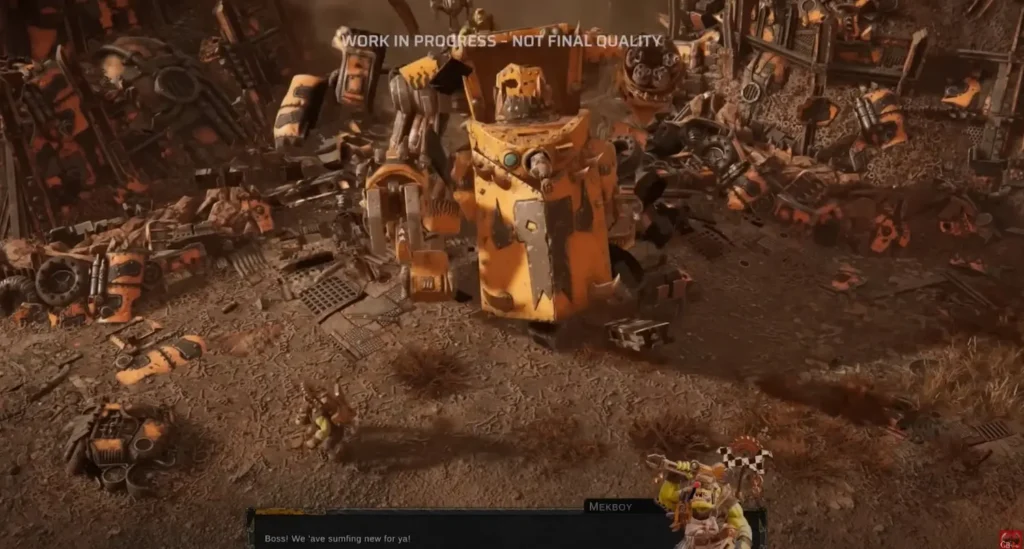
Orks thrive on overwhelming numbers, reckless charges, and turning the battlefield into a brawl that never stops.
Playstyle: Horde, aggression, map control.
- Cheap, fast buildings.
- Swarms of Boyz backed by heavy walkers.
- Cavalry and beast units like Squighog Boyz.
Army abilities: fueled by Waaagh energy, likely involving buffs and area damage.
Ork Units in Dawn of War IV
| Unit | Role | Playstyle and Strengths | Status |
|---|---|---|---|
| Boyz | Core infantry | Cheap, numerous, expendable. Swarm the field and overwhelm enemies. | Confirmed |
| Mekboyz | Specialist unit | Smaller Ork mek unit, often armed with shokk-style weapons and repair tools. Great for ranged support and utility. | Confirmed |
| Nobz | Elite infantry | Heavy-hitting Orks that tear through Marines and Guard. | Speculative |
| Squighog Boyz | Cavalry | Beast riders that flank and chase. Great for disrupting backlines. | Confirmed |
| Lootas | Heavy weapons infantry | Dakka-heavy ranged unit. Excellent at suppressing infantry blobs. | Speculative |
| Deff Dread | Walker | Mid-tier walker. Known for brutal melee and sync kill animations. | Confirmed |
| Killa Kans | Light walkers | Swarms of smaller walkers. Cheap and disruptive. | Speculative |
| Meganobz | Super-elite infantry | Orks in mega armor with power klaws. Slow but devastating in melee, nearly unkillable without anti-armor. | Confirmed |
| Battlewagon | Heavy transport | Can carry Orks while providing ranged dakka. Key to spearheading assaults. | Confirmed |
| Gorkanaut / Morkanaut | Heavy walker | A massive melee-and-dakka powerhouse for late-game pushes. | Confirmed |
| Warboss | Hero | Centerpiece leader unit. Provides buffs and excels in melee. | Confirmed |
Buildings scattered across the map let them churn out units everywhere. Their strength is relentless pressure.
Necrons
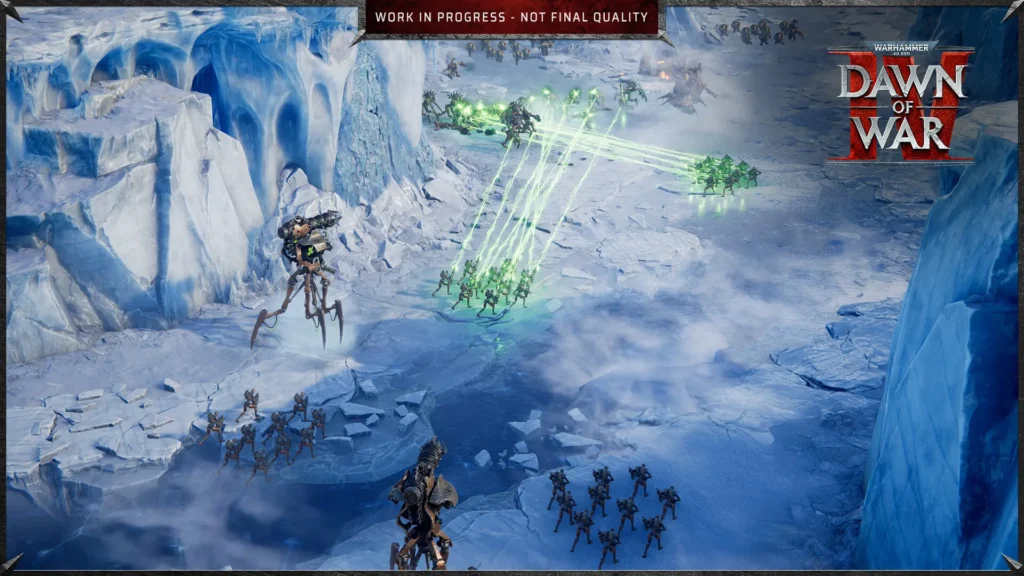
The Necrons are designed to embody inevitability. The devs confirmed that they expand slowly, building tomb structures that increase their overall strength. As they spread, their armies become more resilient and terrifying.
Monoliths and Tomb Spyders anchor teleportation networks, letting them redeploy forces instantly across the battlefield. This is not an army that rushes you early. It is an army that suffocates you over time until you are crushed under the weight of their inevitability.
On the battlefield, Necrons are defined by slow movement, extreme resilience, and terrifying reanimation mechanics. Their units do not rely on requisition and power in the same way as others. Instead, they expand their influence by constructing tomb structures that strengthen their armies.
Their warriors fight in chilling synchrony, unleashing devastating volleys, while their elite Destroyers and Monoliths crush everything that dares resist. Necrons are not about speed or finesse. They are about grinding inevitability, wearing down foes who cannot kill what refuses to stay dead.
Playstyle: Slow, resilient, reanimating.
- Do not use requisition and power in the same way.
- Expand by building tomb structures.
- Units self-heal and reanimate fallen warriors.
- Teleportation enables sudden redeployment.
Army abilities: likely tied to energy from structures, including teleport strikes and devastating energy blasts.Necron Units in Dawn of War IV
| Unit | Role | Playstyle and Strengths | Status |
|---|---|---|---|
| Necron Warriors | Core infantry | Durable infantry that fire synchronized volleys. Anchor points on the battlefield. | Confirmed |
| Immortals | Heavy infantry | Anti-armor specialists with gauss or tesla weapons. | Confirmed |
| Skorpekh Destroyers | Elite melee | Devastating melee specialists that shred elites and walkers. | Confirmed |
| Deathmarks | Snipers | Long-range assassins, excellent for targeting enemy heroes. | Speculative |
| Canoptek Scarabs | Swarm unit | Harassment unit, effective for tying down squads and capturing points. | Speculative |
| Doomstalker | Heavy artillery walker | Long-range anti-armor / infantry walker. | Confirmed |
| Monolith | Super-heavy | Teleports reinforcements, provides reanimation, heavy weapons platform. | Confirmed |
| Obelisk | Support structure | Revives Necron units and counters air threats. | Confirmed |
| Overlord / Cryptek | Hero | Leadership buffs, reanimation abilities, devastating personal weaponry. | Speculative |
Necron armies march slowly but are extremely hard to wipe out. Their psychological impact is just as strong as their firepower.
Adeptus Mechanicus
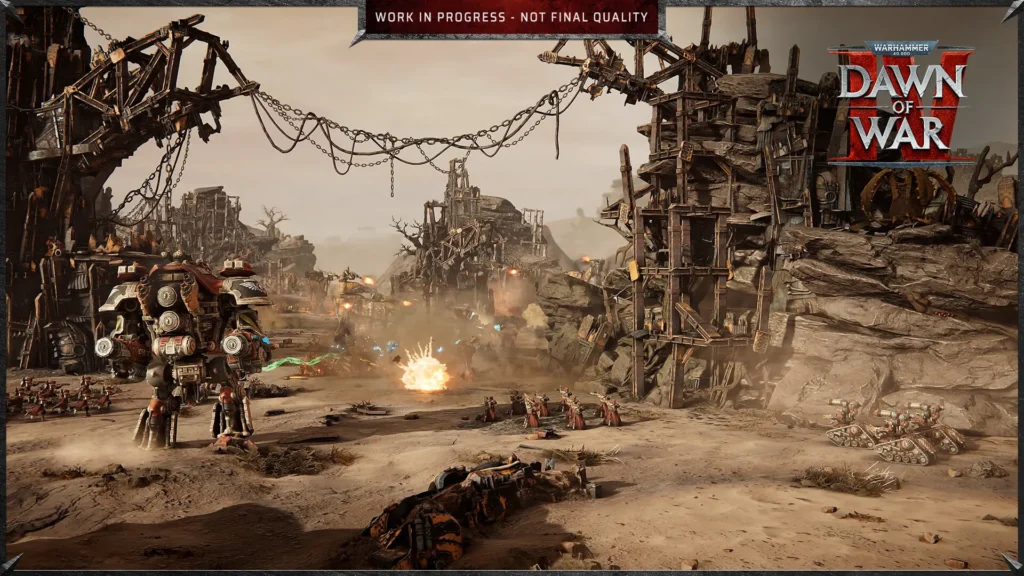
The Adeptus Mechanicus are the keepers of humanity’s most advanced technology, worshipping the Omnissiah and blurring the line between flesh and machine.
Although they have been present in mods and minor cameos in past Dawn of War titles, this is their first time as a fully playable faction. Their inclusion alone signals how far they have risen in popularity within Warhammer 40,000.
In gameplay, the Mechanicus thrive on networked buildings, information warfare, and devastating ranged firepower. Their structures buff one another when placed in proximity, creating a web of synergy that empowers their units.
Skitarii infantry form the backbone of their forces, while Kastelan Robots, Dunecrawlers, and Sicarian Infiltrators provide specialized tools.
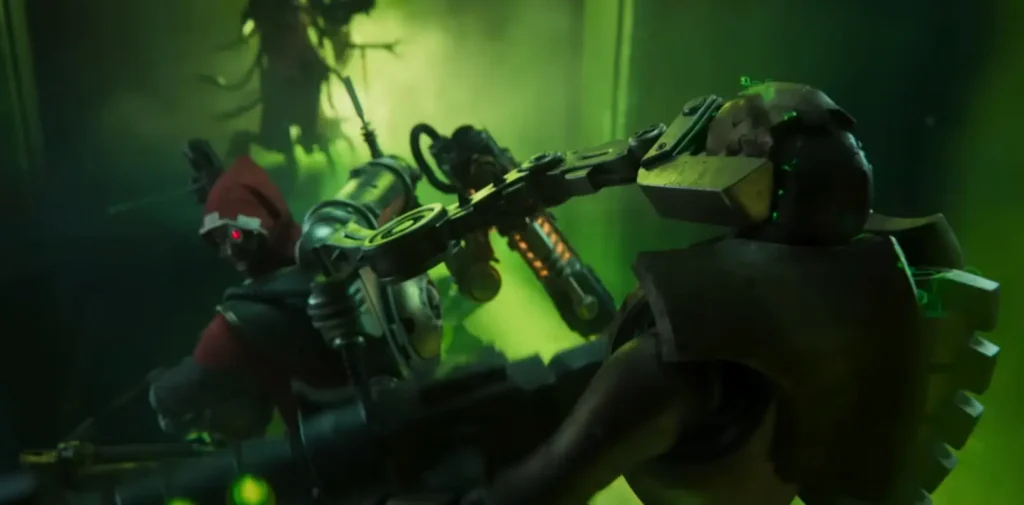
They even have access to Imperial Knights, titanic war machines that dwarf most units. The AdMech style rewards careful positioning, strong defensive networks, and punishing firepower that breaks enemies before they reach your lines.
Playstyle: Technological firepower, buffs, and information warfare.
- Buildings provide buffs when placed close together.
- Units gain benefits near structures.
- Can detect and track enemies in the fog of war.
Army abilities: likely involve orbital scans, long-range strikes, and mechanical reinforcements.Adeptus Mechanicus Units in Dawn of War IV
Adeptus Mechanicus Units in Dawn of War IV
| Unit | Role | Playstyle and Strengths | Status |
|---|---|---|---|
| Skitarii Rangers / Vanguard | Core infantry | Flexible ranged troops. Stronger when near supporting structures. | Speculative |
| Sicarian Infiltrators | Stealth infantry | Ambush and disruption specialists. Great for recon and striking priority targets. | Speculative |
| Kastelan Robots | Heavy walkers | Durable robot units with melee or ranged loadouts. Stronger with Tech-Priest support. | Confirmed |
| Onager Dunecrawlers | Heavy vehicles | Mobile artillery and anti-air. Provide long-range fire support. | Confirmed |
| Electro-Priests | Elite melee infantry | Shock troops that deal massive damage up close but require careful support. | Confirmed |
| Ironstrider Ballistarii / Sydonian Dragoons | Fast walkers | Light skirmishers and mobile fire support. Great for harassing enemy lines. | Speculative |
| Kataphron Destroyers / Breachers | Heavy servitor infantry | Cybernetic shock troops. Either armed with heavy guns (Destroyers) or melee breaching gear (Breachers). Slow but powerful and resilient. | Confirmed |
| Skorpius Disintegrator | Battle tank | Mainline AdMech tank with powerful ranged firepower. Effective at breaking infantry lines and damaging vehicles. | Confirmed |
| Knight Castellan | Super-heavy | Enormous titan-class walker great against enemy armor and bases. | Confirmed |
| Tech-Priest Enginseer / Dominus | Support unit / Leader | Repairs vehicles, buffs robots, and provides battlefield utility. | Confirmed |
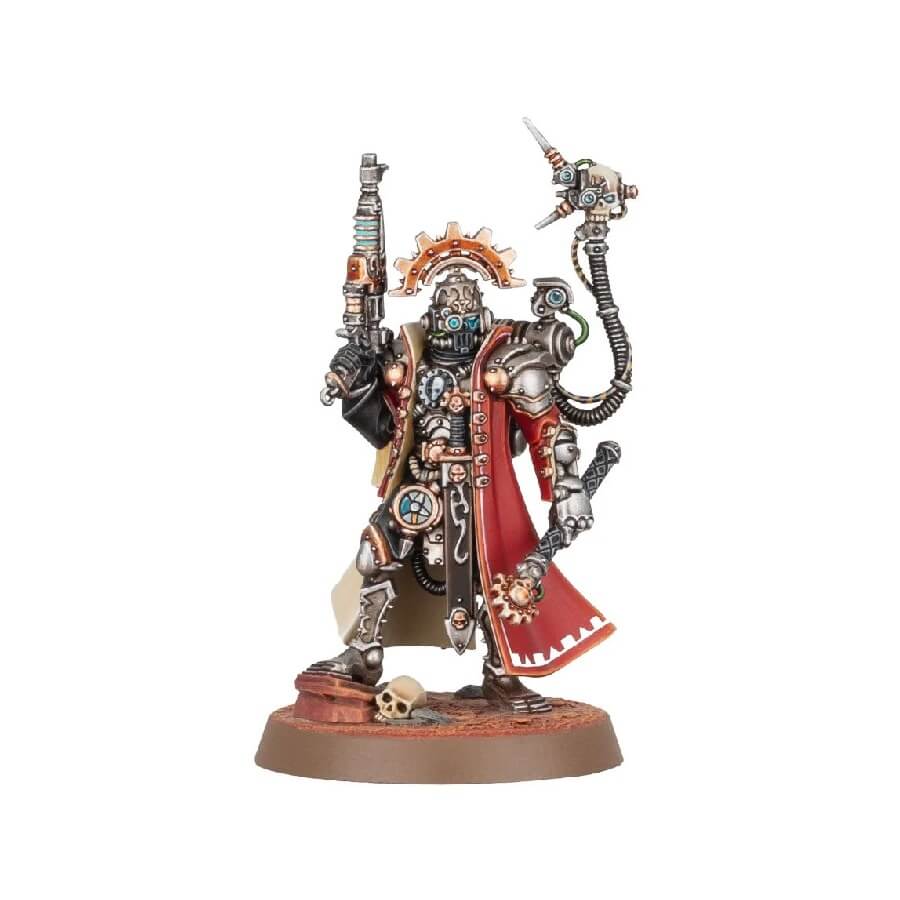
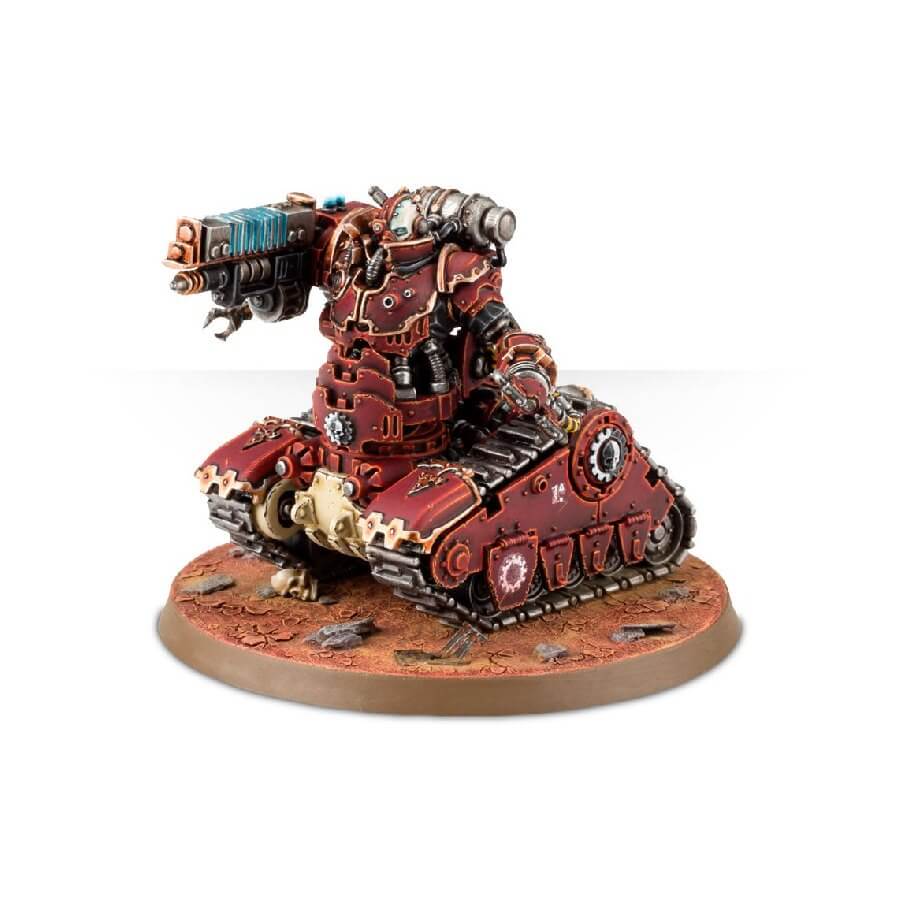
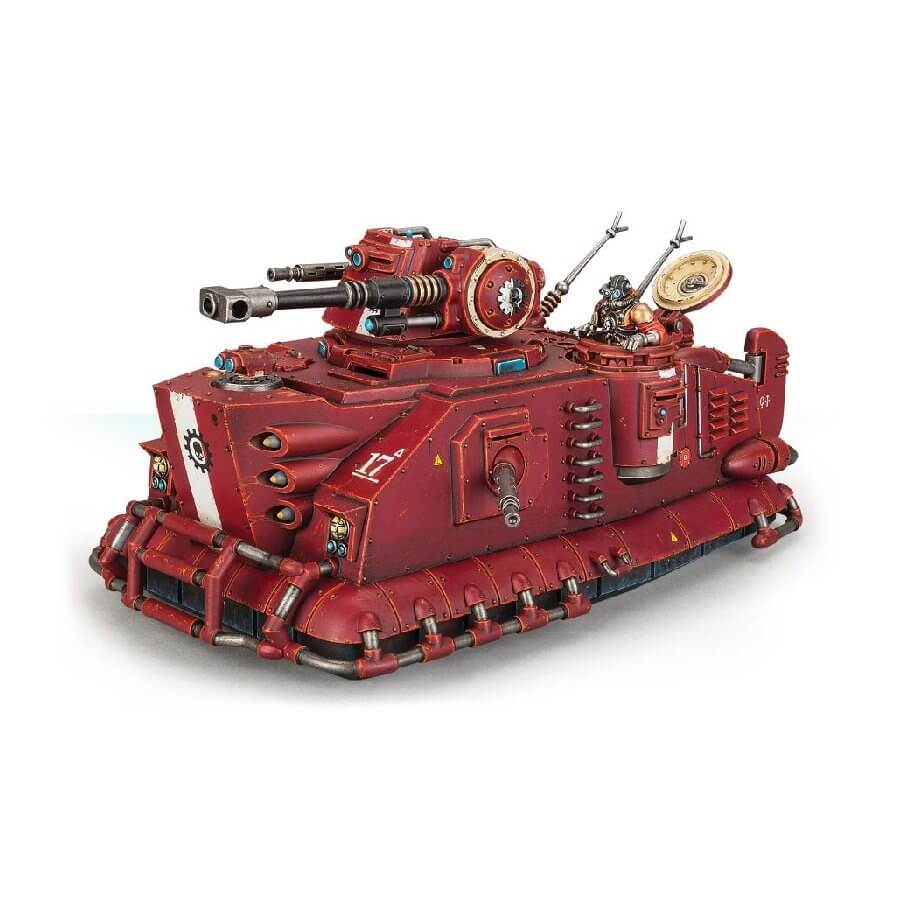
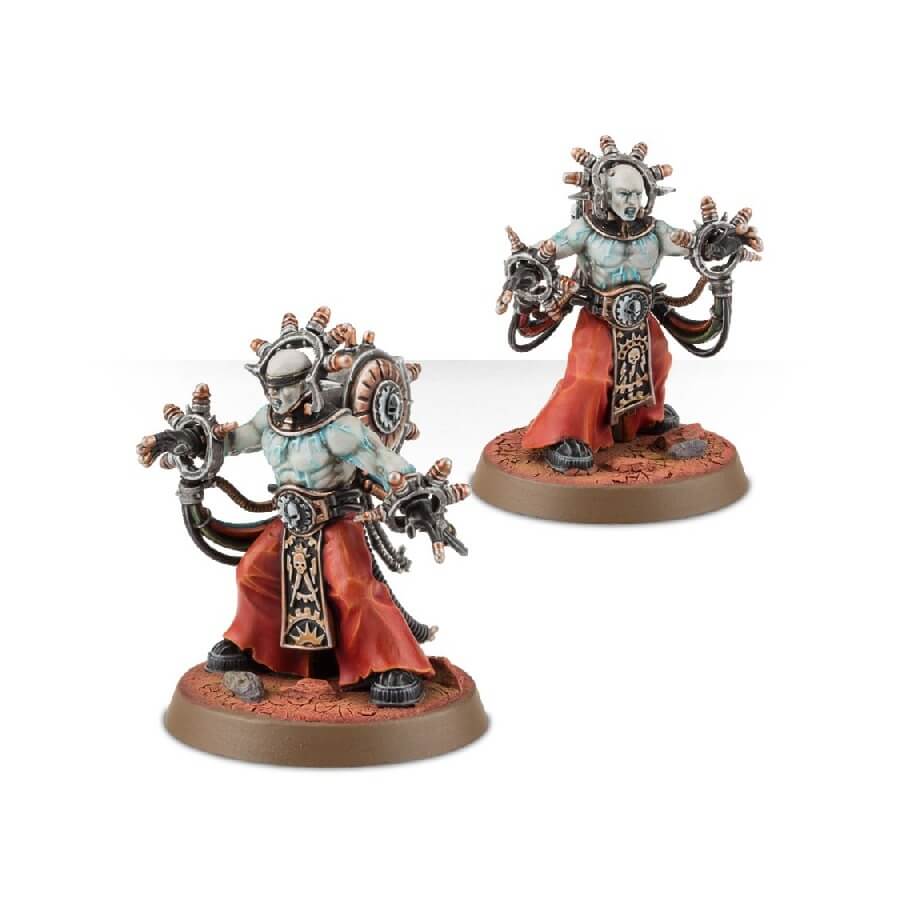
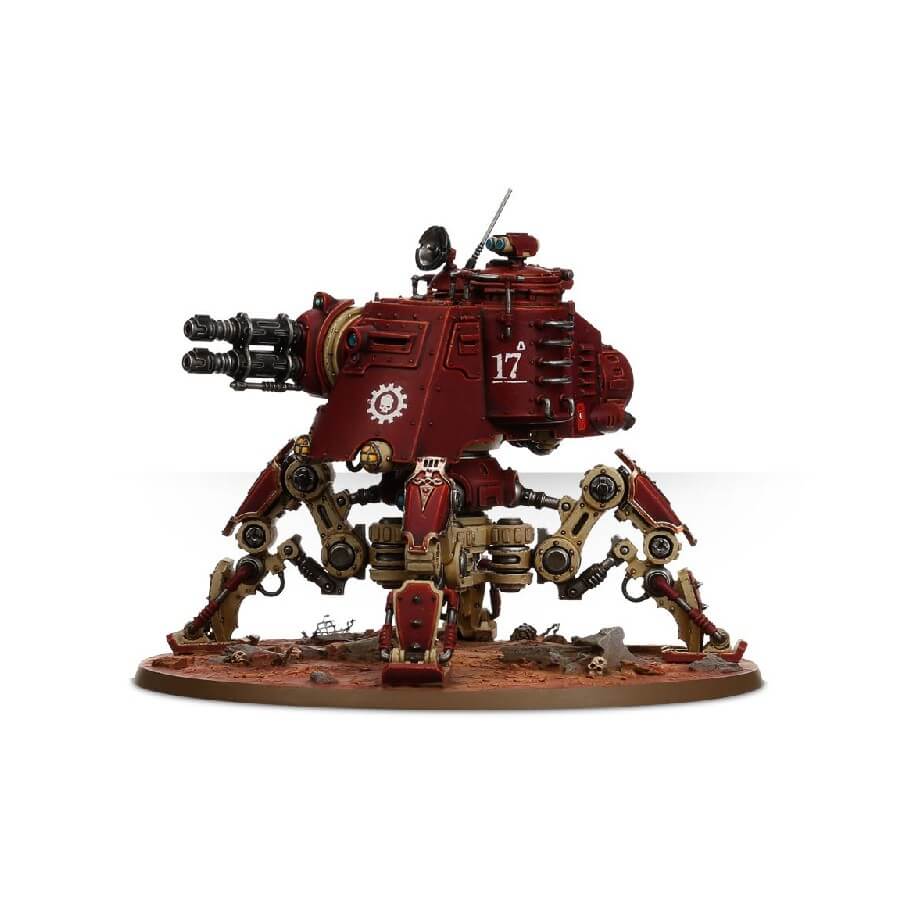
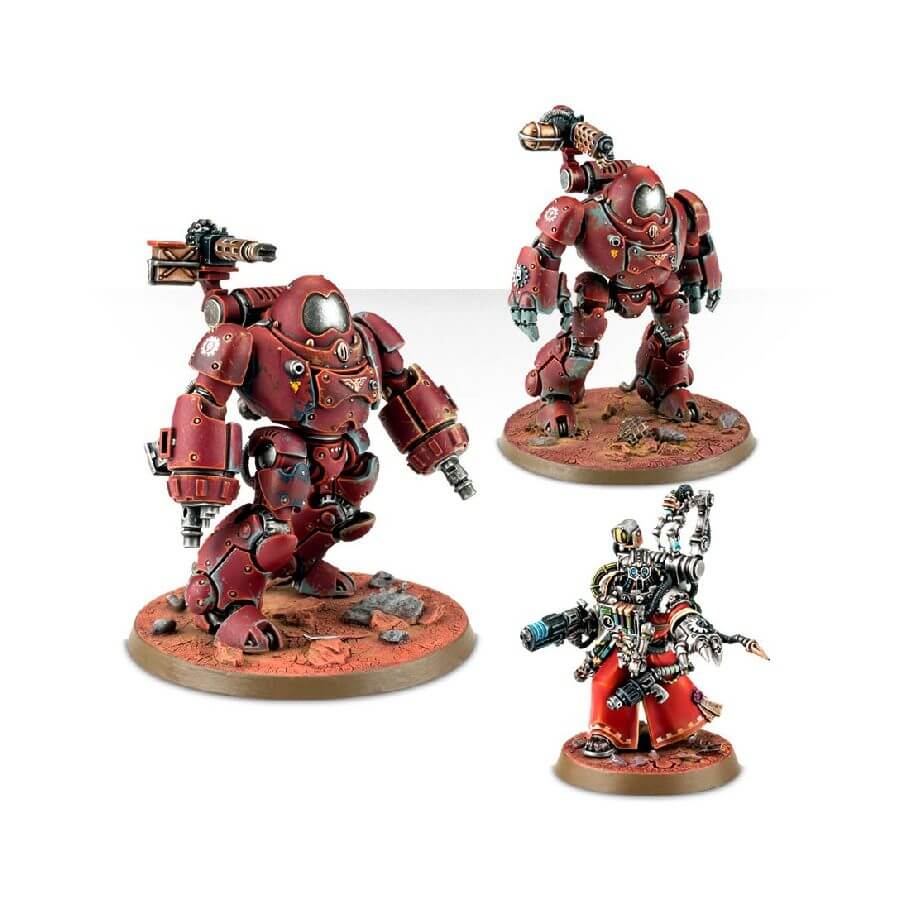
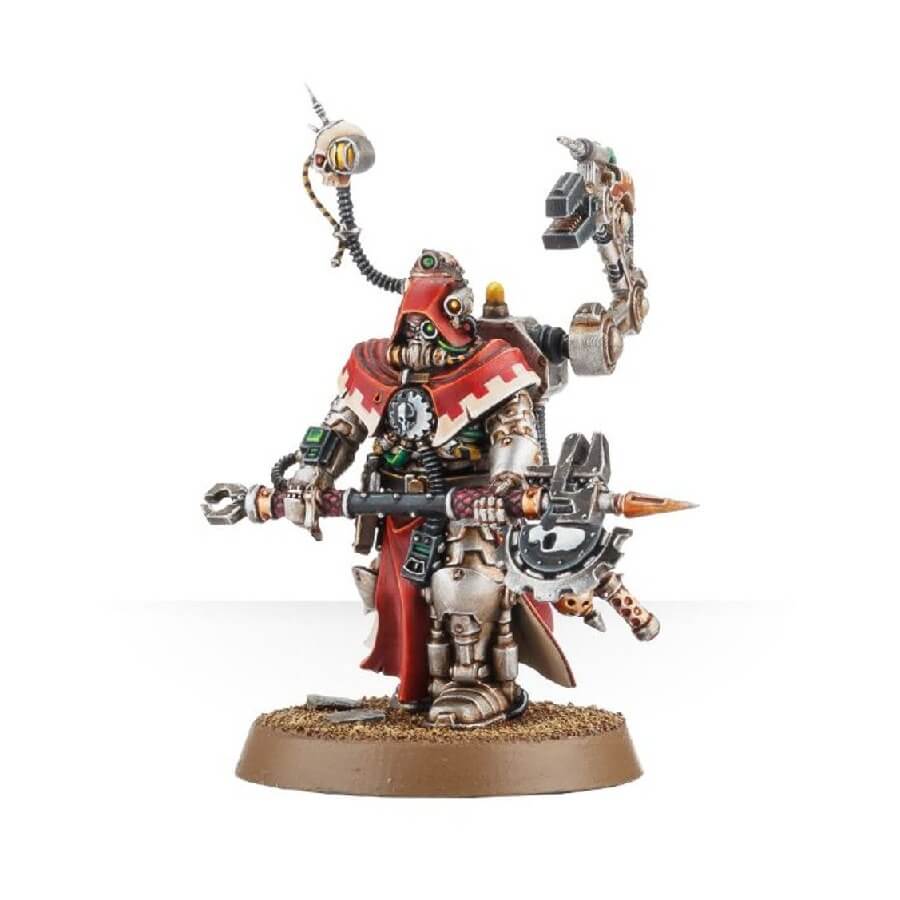
Imperial Guard (Astra Militarum)
The Imperial Guard, or Astra Militarum, represent the might of humanity’s common soldier. They lack the genetic enhancements of Space Marines and the divine machinery of the Adeptus Mechanicus, but they make up for it with numbers, discipline, and sheer weight of firepower.
Although not a fully playable faction at launch, they are confirmed to appear in the tutorial and throughout the campaign.
The Guard embody the human perspective of the 41st Millennium: fragile infantry standing against impossible odds, backed by tanks, artillery, and overwhelming determination.
Cadian Guardsmen march in disciplined lines, supported by Scout Sentinels for scouting and Rogal Dorn tanks for heavy firepower. Bombast field guns provide artillery support.
When the Guard become fully playable, their style will likely revolve around cheap infantry, morale-boosting officers, and devastating artillery barrages. They are the hammer of the Emperor, and even on Kronus they remind us why the Imperium still stands.
Playstyle: Mass infantry, artillery support, armored columns.
Imperial Guard (Astra Militarum) Units Seen So Far
| Unit | Role | Playstyle and Strengths |
|---|---|---|
| Guardsmen Squads | Core infantry | Cheap and fragile, but effective in large numbers. Can dig in and hold ground with support. |
| Scout Sentinels | Light walkers | Fast and lightly armored. Good for scouting, harassing, and delaying enemies. |
| Rogal Dorn Tank | Heavy tank | Strong frontline armor. Effective against both infantry and vehicles. Suited for spearhead assaults. |
| Bombast Field Gun | Artillery | Long-range support. Excellent for bombarding fortified positions. |
| Lord General / Commissar (speculative) | Hero unit | Likely to provide leadership buffs, morale boosts, and call-in abilities like airstrikes or reinforcements. |
Given their full presence in tutorial missions, they are a likely candidate for early DLC.
Dawn of War 4 Release Date and Platforms
Dawn of War IV is planned for 2026 on PC via Steam. No exact date is known yet. No console versions are announced, but the developer’s experience with Iron Harvest on consoles means it could happen later.
What Fans Are Saying
The community reaction mixes hype and caution. Overall, fans welcome the return of base building, sync kills, Last Stand, and multiple campaigns. Concerns remain about graphics style and readability, but the tone is largely positive.
“The fact that AdMech are a starting faction before even Guard really shows how far they have come as a faction, because until now their only actual presence in the series was the Enginseer in DoW1 and that’s it!”
“Just showing a random picture of Robocop when you intro Mechanicus is pretty gold.”
“Looks like the Guard has a pretty good unit variety, without being playable. Just from this vid I could see Guardsmen, Scout Sentinels, Rogal Dorn, Bombast Guns and I’m guessing a Castellan.”
“Maybe making field reinforcements more expensive than base reinforcements is a good middle ground. I tend to like DoW II and CoH mechanics where you have to retreat to replenish.”
“2 things for me that should be addressed. 1. Unit movement, make it more dynamic… 2. Shooting while standing in place, some recoil, firing cycles between individual members. Otherwise it is looking very promising.”
“After seeing the gameplay in the reveal trailer I wasn’t immediately sold. But the more I hear you talk about it, the more the hype grows. I sure hope they deliver.”
“Always liked the sync kills in the original Dawn of War. Watching a Space Marine Captain destroy a greater demon with a hammer to the head was always neat.”
“Deff Dread body slamming the Marine Dread goes hard. Also very cool that Mechanicus gets to be a starting race rather than later.”
“Looks like a return to DoW1 style, absolutely what the series needed. Not that DoW2 was bad, but the series really needed to choose an identity.”
Dawn of War IV is shaping up to be the return to form many of us have been waiting for. From the promise of proper base building and sync kills to the arrival of new factions like the Adeptus Mechanicus, it already feels like the developers are listening to what fans want.
There is still plenty we do not know, and plenty that could change between now and launchm, but what we have seen so far is enough to rekindle excitement for the series.
This article will continue to grow as more information becomes available. Every time new factions, campaign details, or gameplay footage are revealed, I will update this hub so it stays current. If you are as invested in the future of Dawn of War as I am, make sure to check back regularly for fresh updates and insights.
For now, the wait for 2026 begins. Kronus is calling once more, and it looks like it will be worth answering.
References and Sources
- Steam Store Page (Deep Silver / King Art Games)– official product description, campaign and faction details
- Deep Silver Official Newsroom – Gamescom 2025 reveal press release
- GamesRadar Overview – roundup of announcement and gameplay features
- PC Gamer Hands-On Preview – early impressions from demo build
- PC Gamer Development Insight – how Iron Harvest influenced DoW IV
- Wikipedia – Warhammer 40,000: Dawn of War IV entry (general development, release window)
- Dev Interview with The Great Book of Grudges
- YouTube Gameplay & Previews
- Auspex Tactics: https://www.youtube.com/watch?v=sBt-oLvP5UE
- Warhammer: https://www.youtube.com/watch?v=lAPm8fIy5mg
- Zerkovich: https://www.youtube.com/watch?v=4z8tdO3hLoc&t
- Turin: https://www.youtube.com/watch?v=UkTeH8vp8Os&t

